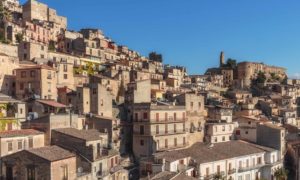Sometimes, there is a certain symmetry to life. Take our relationship with Koeberlé Kreyer, a 257-year-old vintner in the Alsace region of France.
We’ve been going to visit Marie-Paule Koeberlé-Kreyer at Koeberlé Kreyer since we wandered off the Alsatian Wine Route in 2003 and discovered the boutique winery in the little town of Rodern.
Unlike the charming towns around it, Rodern — between St. Hippolyte and the medieval town of Bergheim — has nothing much going for it except wine. But there are a half-dozen small “caves,” or wine vendors, in this little town.
We tried many different vintners in the area including Hugel and Metz-Bleger, just up the street from Koeberle Kreyer. But we liked Koeberlé Kreyer the best. Not all their wines were brilliant. But visiting Marie-Paule each time was fun. And by and large, her wine is outstanding and the prices affordable considering some of the grand crus can fetch up to 200 euros per bottle.
(Still, the best Alsatian wine is dirt cheap compared to Bordeaux such as Pétrus, Cheval-Blanc and Margeaux, which now can go for thousands per bottle.)
When we left Europe for the United States in early 2007, one of our last tasks was going back to Rodern and stocking up on Pinot Blancs, Pinot Gris, Rieslings, Gewürztraminers and Crémants. We saved those cases for special occasions such as the day we got our big investor for our digital news company.
We were going to drink our last bottle of Crémant for our 20th wedding anniversary, but forgot. It was okay … we drank it the day we sold our business.
Opening the final bottle – a Riesling – from that 2007 trip was the climax of a party when we decided to sell our house and return to Europe to start Dispatches Europe. After 10 years, it was still great … unusual for a white.
Finally, we returned just a few days ago. And nothing had really changed, thank God.
Walking into their courtyard, I was thrilled to see Koeberlé Kreyer is exactly the same colorful, prosperous and tidy place I remembered from all those years ago.
Real ‘authenticity’
These days, everyone in nearly every consumer business from restaurants to bourbon wants to project authenticity. I call it Keebler Elves Marketing Syndrome – the desire to create the illusion that elves bake cookies in a tree, or some giant distillery in Kentucky or Tennessee is really just a bunch of good old boys sitting around a holler making a batch of whiskey just for you.
In Alsace, there really are still family vintners making a few thousand cases of wine pretty much as they have for centuries. And you can pull up to the door and buy the best of them for ridiculously low prices.
Unlike the Mondavis or Davises, these are not super-wealthy people. They’re just work-a-day Pierres and Natalies, many of whom only now are pushing into markets outside France.
When she found out we were living in the Netherlands, Marie-Paule told us proudly that she is now selling through a dealer – Wijnkoperij Wesseling – in the wealthy enclave of Laren near Hilversum. Her evolution over the years speaks volumes about her business acumen.
When we first started visiting Marie-Paule and Koeberle Kreyer, she spoke rudimentary English, roughly equivalent to my college French. We got on famously. Over the years, as more and more visitors came in search of her wines, the common language increasingly was English. So, she went to night classes and learned English.
Wine is just part of the experience
This is the part where I’m supposed to talk about bouquet, nose, fruit and body. But honestly, we are no connoisseurs. All we know is, we get wonderful bottles of handmade wine for less than 10 euros.
How good is Alsatian wine and Koeberlé Kreyer?
You know, we like what we like, and our friends generally like the wines we buy, as well. That’s all that really matters.
But while we were there, a couple came into the Koeberlé Kreyer tasting room who I mistook for French because they were so fluent. They turned out to be English, living in Geneva. And they’d driven up from Switzerland just to top up their cellar. What’s that say?
I’m not going to try to dazzle you with my wine savvy. All I’m saying is, if you like wine and you’re an expat in, say, Amsterdam, Brussels or Paris, a drive out to Alsace is a lot of fun.
Sitting between the low mountains of the Vosges in France and the Black Forest in Germany, the Alsatian Wine Route is nothing if not scenic. There are huge castles such as Koenigsbourg sitting above the valley. The slopes of the hills are covered in vineyards up to the tree lines. Every village is a tight little cluster of half-timbered houses and ancient streets dating back to Medieval times, and each vies to be named the most beautiful Village des Fleurs in France.
The food is substantial and honest and the people are friendly. You can picnic and hike in the vineyards.
Our experiences over the years from Colmar to Strasbourg were memorable enough that we talked about Alsace incessantly when we lived in the U.S. Amazingly, going back after a decade, it turned out to be everything we remembered … and everything we’d missed.
As we were packing up the wine we bought, Marie-Paule stood up from taping the boxes, smiled and said in French, “Next time, don’t wait 10 years before you come back!”
A little insight into Cremant vs. Champagne:
Alsace is known for both Pinot Noirs and Crémant. I have to say, we really loved the Crémant.
Back in 2002, I went (without telling my wife, Cheryl) to our Army base exchange in Germany and paid about $40 for a bottle of Moët & Chandon. It was middling at best — crisp and yeasty like good Champagne should be, though a bit too sweet and characterless for our tastes.
A few weeks later, we opened a bottle of 6-euro Crémant from Rodern, and Cheryl wanted to kill me. “You paid $40 for that Champagne when this is ten times better!”
But here’s the thing. While the wines are grown and bottled by the individual caves in Alsace, the Crémants are not.
Small vintners shy away from making their own sparking wines because the Champagne method is so complex. First, the juice has to be carefully blended, bottled, injected with a special yeast and sugar solution, then capped. The fermenting sludge sits for up to three years before it’s “degorged,” or opened and the sediment removed. Finally, the bottle is corked for a second stage of in-bottle fermentation.
Crémant is basically Champagne. But because this is a sparkling wine made in Alsace, not the Champagne region of France just east of Paris, it can’t be called Champagne. Yet just like its more glamorous cousin, Crémant is made with the labor-and-cost intensive méthode champenoise, and some of the same grapes.
Crémant differs from Champagnes in that it’s typically a blend of Pinot Noir, Tokay and Chardonnay grapes, whereas the best Champagne is made completely from Chardonnay or Pinot Noir grapes.
What makes Crémant inexpensive is two things.
First, a kilo of grapes costs a lot less in Alsace than in the Champagne region. Second, Crémant, unlike the Tokays, Rieslings and other Alsatian wines, are made by several large producers, not by the individual caves.
“There is just too much know-how and equipment for us to produce our own Crémant,” Marie-Paule told me years ago. “However, more and more small vintners like us are starting to invest in the equipment. If we could make enough, we could compete with Champagne on both quality and price.”
So few bottles of Crémant are produced — perhaps 50,000 — that they’re all consumed either by locals or sold to the steady stream of tourists to Alsace.
Co-CEO of Dispatches Europe. A former military reporter, I'm a serial expat who has lived in France, Turkey, Germany and the Netherlands.



















